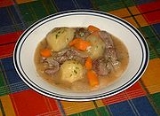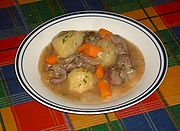
Irish stew
Encyclopedia

Stew
A stew is a combination of solid food ingredients that have been cooked in liquid and served in the resultant gravy. Ingredients in a stew can include any combination of vegetables , meat, especially tougher meats suitable for slow-cooking, such as beef. Poultry, sausages, and seafood are also used...
made from lamb
Lamb (food)
Lamb, mutton, and hogget are the meat of domestic sheep. The meat of a sheep in its first year is lamb; that of a juvenile sheep older than 1 year is hogget; and the meat of an adult sheep is mutton....
, or mutton, (mutton is used as it comes from less tender sheep over a year old and is fattier and has a stronger flavour) as well as potato
Potato
The potato is a starchy, tuberous crop from the perennial Solanum tuberosum of the Solanaceae family . The word potato may refer to the plant itself as well as the edible tuber. In the region of the Andes, there are some other closely related cultivated potato species...
es, carrot
Carrot
The carrot is a root vegetable, usually orange in colour, though purple, red, white, and yellow varieties exist. It has a crisp texture when fresh...
s, onion
Onion
The onion , also known as the bulb onion, common onion and garden onion, is the most widely cultivated species of the genus Allium. The genus Allium also contains a number of other species variously referred to as onions and cultivated for food, such as the Japanese bunching onion The onion...
s, and parsley
Parsley
Parsley is a species of Petroselinum in the family Apiaceae, native to the central Mediterranean region , naturalized elsewhere in Europe, and widely cultivated as an herb, a spice and a vegetable.- Description :Garden parsley is a bright green hairless biennial herbaceous plant in temperate...
.
---Davidson, Alan. (1999). Oxford Companion to Food. Oxford: Oxford University Press. (p. 407).
History
Stewing is an ancient method of cooking meats that is common throughout the world. However, the Celts did not possess their first bronze cauldrons, copied from Greek models, until the seventh century BC. After the Celtic invasion of IrelandPrehistoric Ireland
The prehistory of Ireland has been pieced together from archaeological and genetic evidence; it begins with the first evidence of Mesolithic hunter-gatherers settling in Ireland around 7000 BC and finishes with the start of the historical record, around AD 400. The prehistoric period covers the...
, the cauldron (along with the already established spit) became the dominant cooking tool in ancient Ireland, oven
Oven
An oven is a thermally insulated chamber used for the heating, baking or drying of a substance. It is most commonly used for cooking. Kilns, and furnaces are special-purpose ovens...
s being practically unknown to the ancient Gaels
Gaels
The Gaels or Goidels are speakers of one of the Goidelic Celtic languages: Irish, Scottish Gaelic, and Manx. Goidelic speech originated in Ireland and subsequently spread to western and northern Scotland and the Isle of Man....
. The root vegetables and meat (originally goat) for the stew were then all in place, save for the potato. The introduction of the potato, originally a South American crop, did not occur until after the sixteenth century.
More recent developments in Irish stews have included the adding of stout beer, starting in the twentieth century. In parts of the Irish diaspora
Irish diaspora
thumb|Night Train with Reaper by London Irish artist [[Brian Whelan]] from the book Myth of Return, 2007The Irish diaspora consists of Irish emigrants and their descendants in countries such as the United Kingdom, the United States, Canada, Australia, Argentina, New Zealand, Mexico, South Africa,...
where sheep are less common than in Ireland, such as in Canada and the United States, other meats may be substituted to create a new local variant. Primarily this means beef
Beef
Beef is the culinary name for meat from bovines, especially domestic cattle. Beef can be harvested from cows, bulls, heifers or steers. It is one of the principal meats used in the cuisine of the Middle East , Australia, Argentina, Brazil, Europe and the United States, and is also important in...
, but also wild or farmed game meats such as moose
Moose
The moose or Eurasian elk is the largest extant species in the deer family. Moose are distinguished by the palmate antlers of the males; other members of the family have antlers with a dendritic configuration...
, wapiti
Elk
The Elk is the large deer, also called Cervus canadensis or wapiti, of North America and eastern Asia.Elk may also refer to:Other antlered mammals:...
, or bison
Bison
Members of the genus Bison are large, even-toed ungulates within the subfamily Bovinae. Two extant and four extinct species are recognized...
.
In literature and publications
- Irish stew appears in a famous sequence in the novel Three Men in a BoatThree Men in a BoatThree Men in a Boat ,The Penguin edition punctuates the title differently: Three Men in a Boat: To Say Nothing of the Dog! published in 1889, is a humorous account by Jerome K...
, in which the narrator humorously claims that "Irish stew" consists of whatever leftovers one can find.
In music
- In the Irish drinking song "Johnny McEldoo", Irish stew is one of the first things the title character consumes on his eating spree.
- In the sixth verse of Tom Lehrer's mock Irish ballad, "Rickett Ticketty Tin", the featured maid serves her infant sibling as an Irish stew to the neighbours on a whim of boredom.
In radio
- Russell McHugh, while a breakfast presenter on All FMALL FMAll FM is a local Community Radio station serving south, central and east Manchester and based in the South Manchester suburb of Levenshulme. The station is run by paid staff and volunteers living in its coverage area....
in 2000, successfully convinced listeners that his name was Cockney Rhyming SlangCockney rhyming slangRhyming slang is a form of phrase construction in the English language and is especially prevalent in dialectal British English from the East End of London; hence the alternative name, Cockney rhyming slang...
for Irish Stew (as in, "I'll have a bowl of Russell McHugh"). When the April FoolApril Fools' DayApril Fools' Day is celebrated in different countries around the world on April 1 every year. Sometimes referred to as All Fools' Day, April 1 is not a national holiday, but is widely recognized and celebrated as a day when many people play all kinds of jokes and foolishness...
was revealed, two ManchesterManchesterManchester is a city and metropolitan borough in Greater Manchester, England. According to the Office for National Statistics, the 2010 mid-year population estimate for Manchester was 498,800. Manchester lies within one of the UK's largest metropolitan areas, the metropolitan county of Greater...
restaurants changed the name of the dish in his honour.
See also
- CawlCawlCawl is the Welsh word for soup or broth. The term is used in English to refer to traditional Welsh stews, usually containing meat and vegetables. Its ingredients tend to vary, but lamb and leeks are particularly common, owing to their association with Wales....
- Lancashire HotpotLancashire HotpotLancashire hotpot is a dish made traditionally from lamb or mutton and onion, topped with sliced potatoes, left to bake in the oven all day in a heavy pot and on a low heat. Originating in the days of heavy industrialisation in Lancashire in the North West of England, it requires a minimum of...
- Scotch brothScotch brothScotch broth is a filling soup, originating in Scotland but now obtainable worldwide. The principal ingredients are usually barley, stewing or braising cuts of lamb or mutton , and root vegetables such as carrots, turnips or swedes. Greens, particularly cabbage and leeks, can also be added, usually...
- ScouseScouse (food)Scouse is a type of lamb or beef stew. The word comes from lobscouse or lapskaus, Norwegian for "stew" and refers to a meat based stew commonly eaten by sailors throughout Northern Europe, which became popular in seaports such as Liverpool.-Origin of the term:In the 18th and 19th centuries...
- List of Ireland-related topics

